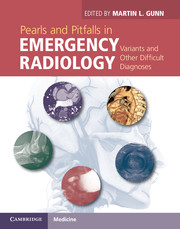Book contents
- Frontmatter
- Contents
- List of contributors
- Preface
- Acknowledgments
- Section 1 Brain, head, and neck
- Section 2 Spine
- Section 3 Thorax
- Case 30 Pseudopneumomediastinum
- Case 31 Traumatic pneumomediastinum without aerodigestive injury
- Case 32 Pseudopneumothorax
- Case 33 Subcutaneous emphysema and mimickers
- Case 34 Tracheal injury
- Case 35 Pulmonary contusion and laceration
- Case 36 Sternoclavicular dislocation
- Case 37 Boerhaave syndrome
- Case 38 Variants and hernias of the diaphragm simulating injury
- Section 4 Cardiovascular
- Section 5 Abdomen
- Section 6 Pelvis
- Section 7 Musculoskeletal
- Section 8 Pediatrics
- Index
- References
Case 36 - Sternoclavicular dislocation
from Section 3 - Thorax
Published online by Cambridge University Press: 05 March 2013
- Frontmatter
- Contents
- List of contributors
- Preface
- Acknowledgments
- Section 1 Brain, head, and neck
- Section 2 Spine
- Section 3 Thorax
- Case 30 Pseudopneumomediastinum
- Case 31 Traumatic pneumomediastinum without aerodigestive injury
- Case 32 Pseudopneumothorax
- Case 33 Subcutaneous emphysema and mimickers
- Case 34 Tracheal injury
- Case 35 Pulmonary contusion and laceration
- Case 36 Sternoclavicular dislocation
- Case 37 Boerhaave syndrome
- Case 38 Variants and hernias of the diaphragm simulating injury
- Section 4 Cardiovascular
- Section 5 Abdomen
- Section 6 Pelvis
- Section 7 Musculoskeletal
- Section 8 Pediatrics
- Index
- References
Summary
Imaging description
On chest radiographs, a difference in the relative craniocaudal positions of the medial clavicles of greater than 50% of the width of the clavicular heads is suggestive of sternoclavicular joint (SCJ) dislocation (Figure 36.1) [1]. While a number of additional specific radiographic views including the serendipity (Rockwood) (Figure 36.2), Hobb, Kattan, and Heinig views have been proposed, CT is the best study to perform when SCJ dislocation is suspected. CT helps characterize dislocation as either anterior or posterior and is useful for assessing associated injuries [2]. If a posterior dislocation is suspected, we perform CT angiography of the mediastinum as part of the evaluation (Figure 36.3).
Sternoclavicular joint dislocations are rare injuries [3]. Less than 2–3% of all dislocations involving the pectoral girdle involve the sternoclavicular joint [4]. Anterior or presternal displacement is much more common than posterior displacement [5].
Importance
Although anterior dislocations have limited skeletal morbidity, they indicate high-energy trauma and more than two-thirds of anterior dislocations are associated with other serious injuries including pneumothorax, hemothorax, and pulmonary contusions [5].
- Type
- Chapter
- Information
- Pearls and Pitfalls in Emergency RadiologyVariants and Other Difficult Diagnoses, pp. 121 - 124Publisher: Cambridge University PressPrint publication year: 2013

